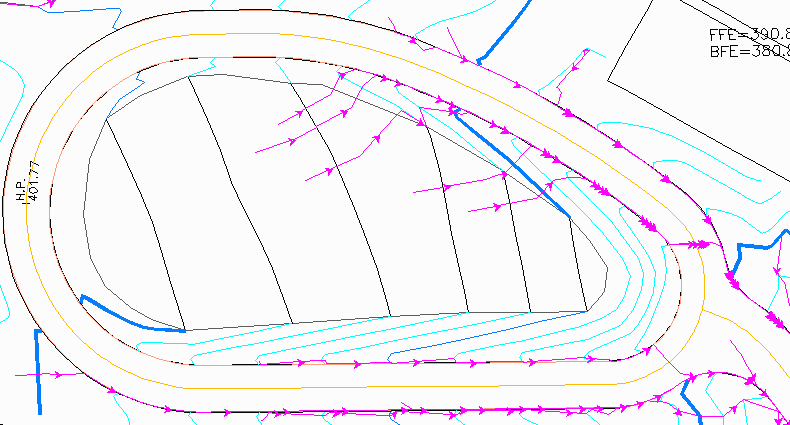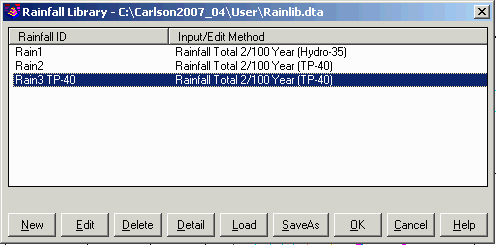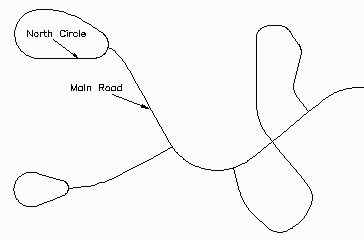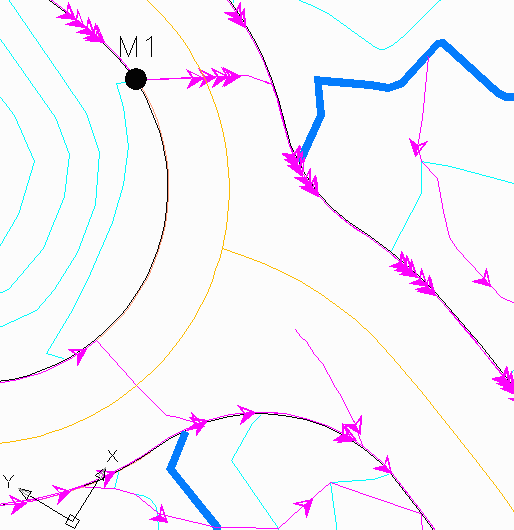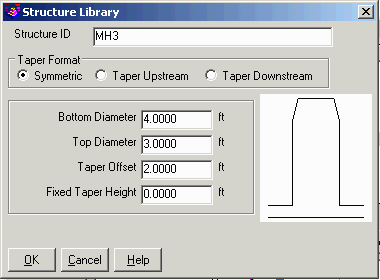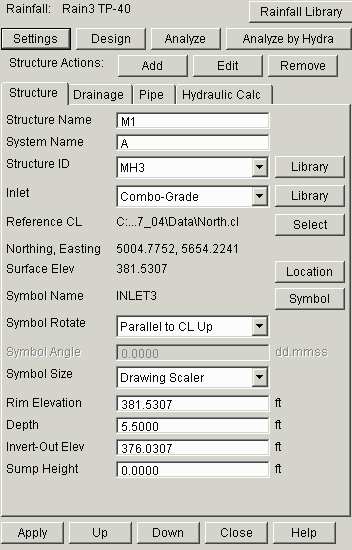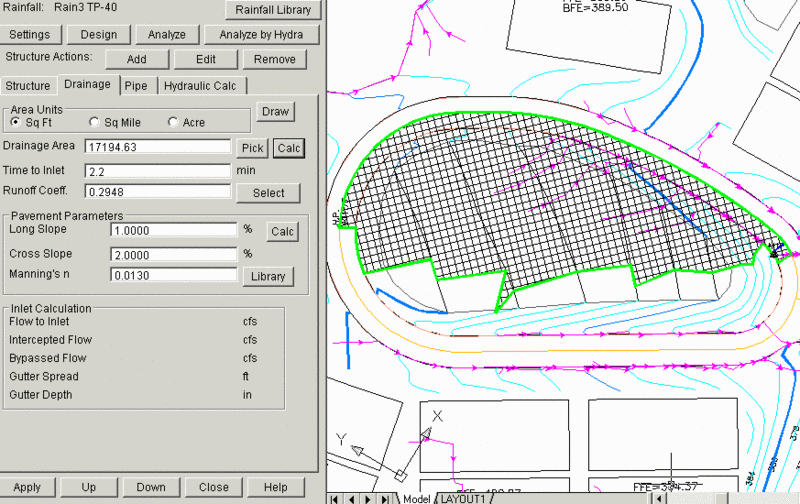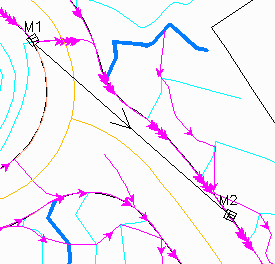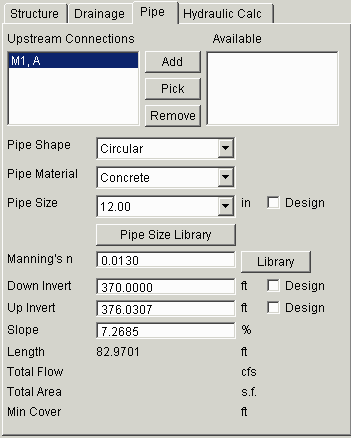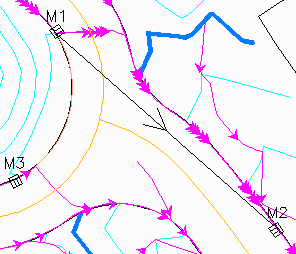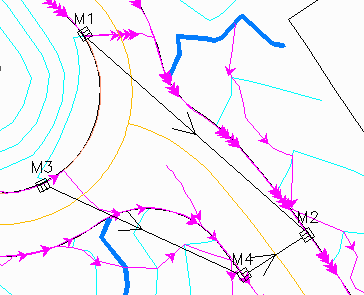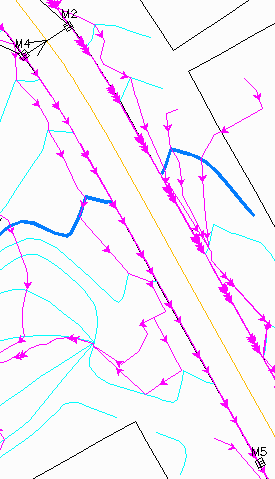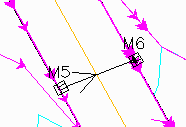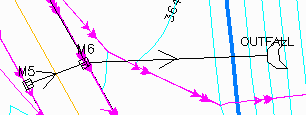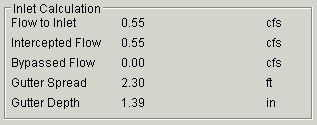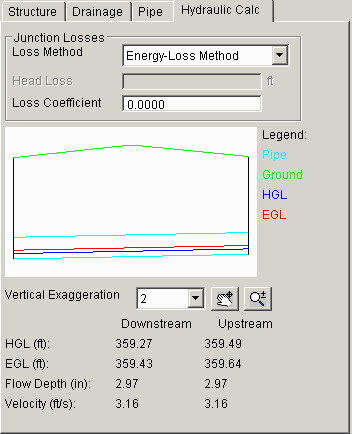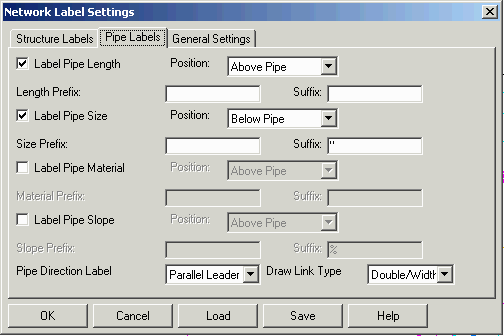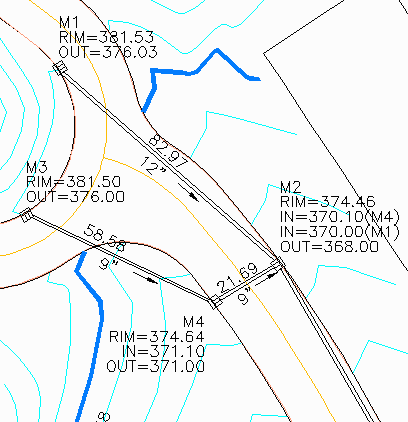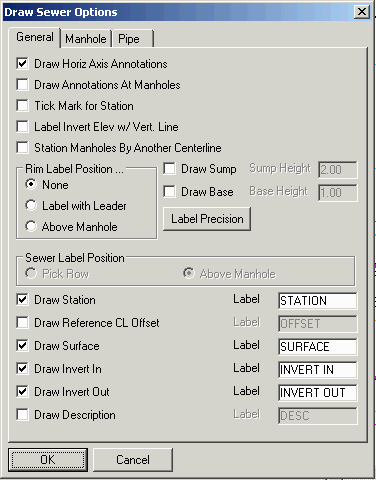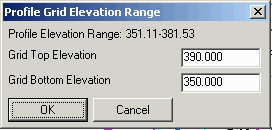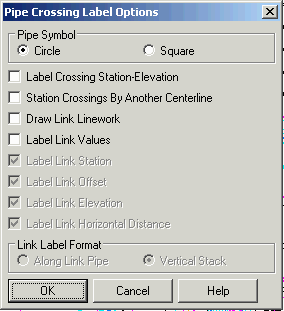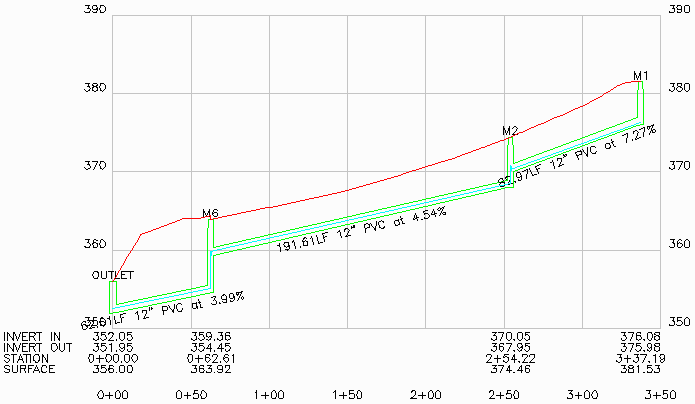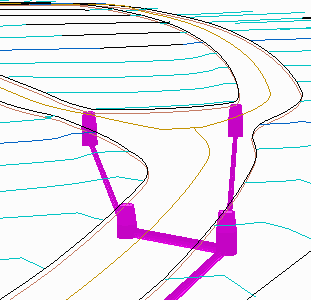Lesson 12: Stormwater Network Design
In this tutorial, we'll layout the structure and
pipes for the stormwater drainage and analyze the flow for a portion of
a site. We'll use the tools to automatically calculate the drainage and
runoff
coefficients. These automated methods require setup of a surface and
runoff regions. Alternatively, these tools can be skipped in which case
the drainage areas and runoff coefficients for the inlets can be
entered manually into the sewer network.
Step 1 - Open Drawing
From the File menu, choose Open and select
EXAMPLE3.dwg
from the Carlson Work folder (ie.
C:\Carlson2007\WORK\EXAMPLE3.dwg).
Step 2 - Make Surface Model
The drawing entities for the design surface that we will use to model
drainage have already been prepared. These entities consist of design
contours, elevated pad perimeter polylines, spot elevations and 3D
polylines for the road centerlines and face of curbs.
To model the drainage, the program can use either triangulation or grid
surfaces. For this example, triangulation is used so that the flow can
follow the edges of the road. In general, triangulation is needed
for surfaces with breaklines and grids are useful for surfaces defined
by contours alone.
Run the Triangulate & Contour command from the Surface menu. In the
dialog, go to the Contour tab and turn off Draw Contours. Then in the
Triangulate tab, turn on Draw Triangulation Faces, Write Triangulation
File, Use Inclusion/Exclusion Areas and Ignore Zero Elevations. Pick
the Browse button, choose a faster and more efficient TIN format, and
set the file name as Example3.tin. Then pick OK.
At the command line, the program will
prompt for the inclusion and exclusion perimeters. Pick the perimeter
polyline for the inclusion and nothing for exclusion. Next, for the
select objects to triangulate, enter All and press Enter.
Select the Inclusion perimeter
polylines or ENTER for none.
Select objects: pick the perimeter polyline
Select objects: press Enter
Select the Exclusion perimeter
polylines or ENTER for none.
Select objects: press
Enter
Select the points and breaklines to
Triangulate.
Select objects: All
Select objects: press
Enter
Reading points... 11149
Inserted 11149 points
Inserted 10896 breakline segments
Writing Triangulation File:
C:\carlson2007_04\data\example3.tin
Drawing Triangulation 3D Faces ...
Step 3 - Check Surface
This step is optional to verify that the surface is good by
checking for bad elevation data points and that the surface follows the
data points.
With the triangulation drawn as 3D Faces, run the 3D Viewer Window
command in
the View menu. At the command line, it will prompt to select the
objects to view. Enter All and press Enter.
Select all entities for the scene.
Select objects: All
Select objects: press Enter
In the 3D Viewer dialog, move the pointer near the center of the
graphic and the cursor will change to a X/Y symbol which is the X/Y
axis rotation mode. Click down the left mouse button and drag down to
rotate the site to a good viewing angle. Then move the pointer near the
edge of the graphic and the cursor will change to a Z symbol which is
the Z axis rotation mode. Click down the left mouse button and drag
around to rotate the pile. To fill in the triangulation faces, pick the
Shade icon.  You can also choose the
Color By Elevation toggle for better viewing of the
elevation range.
You can also choose the
Color By Elevation toggle for better viewing of the
elevation range.
The surface looks right in the 3D Viewer. The site has a slope from the
top road circle down towards the detention ponds at the bottom. Close
the 3D Viewer by
choosing the Exit Door button. We don't need the 3D Faces anymore.
Let's delete them by running Erase By Layer in the Edit menu. Choose
the Select Layers From Screen and pick any 3D Face. Then pick the OK
button.
Step 4 - Runoff Coefficients
This
step sets up layers that are
assigned Rational Method runoff
coefficients and applied to closed polylines on the specified layers.
The runoff coefficients are the C-Factors in the
Rational
Equation Q = C*I*A. Q is flow, I is rainfall intensity and A is
area. The runoff polyline areas use region logic where a polyline
inside
another on the same layer is used as an exclusion. A limitation is that
polylines on the same layer must not intersect each other. For
polylines on different layers, there can be polylines within other
polylines and for any given point, the smallest enclosing polyline is
used to determine the runoff coefficient.
In this example, the
site perimeter polyline is on the Regions layer, the building pads are
on the Pads layer and the edge of pavement polylines are on the Roads
layer. All these polylines are already closed polylines. So we're ready
to assign the runoff coefficients to the layers. Run Define Runoff
Layers in the
Watershed menu. Begin with an
empty dialog by deleting any
existing layers in the table. Select the Add
button.
Let's add the road layer first. Use the
Select button next to the Layer field and select the layer name ROADS
from the list or screen pick a road polyline. Next choose the Library
button and select Streets, Asphaltic from the list. Under the Draw
Settings, set the Hatch Color to Magenta. When the dialog is set as
shown, pick OK.
Repeat the Add function for the Pads layer and set the runoff to
Roofs and the color to Red. And repeat add for the Regions layer and
set the runoff to Unimproved Areas and the color to Green.
From the main dialog, pick the Hatch All which gives a visual check
of the runoff coefficient areas. The areas within the
buildings are inside both the Region and Pads polylines and the Pads
govern because they are the smaller area. Likewise the road areas are
governed by the Roads layer and road interior islands are not counted
for Roads because the interior Roads polyline acts as an exclusion
perimeter. The rest of the area is set to the Regions layer.
With the three layers defined, click OK
from the main dialog.
We don't need to keep the runoff hatches.
Let's delete them by running Erase By Layer in the Edit menu. Choose
the Select Layers From Screen and pick any hatch to get the
RUNOFF_HATCH layer. Then pick the OK
button.
Step 5 - Watershed Analysis
From the Watershed menu, pick Watershed Analysis and when prompted for
the surface file, choose Example3.tin. The program dialog docks on the
left side of the drawing.
Before processing the watersheds, set the Rainfall to 1 inch. The
program uses the runoff volume calculated from the rainfall depth and
drainage areas to figure when the runoff is enough for the flow to go
through a low point. If the rainfall depth is set to zero, then the
flow lines will stop at every low point or dimple in the surface. At
this point, we have not defined our storm event to know the actual
rainfall depth. If we did get the storm rainfall depth, we could enter
it. For now we're just using Watershed Analysis to give a general idea
of the watershed areas and runoff flow lines.
The next step is to pick the Process button and the program calculates
the flow connections between each triangle. Once the surface is
processed, we can run any of the analysis tools. First, go to the
Options tab and turn on Fill Watershed Areas, Draw Sink Locations and
Draw Pond Areas.
Go back to the Tools tab and pick the
Draw Watershed Areas button. Each watershed area is drawn with a closed
polyline and solid filled with different colors. Also, for each
watershed the sink (lowest point ) is drawn with a solid circle symbol.
The areas covered by ponding are drawn as solid blue hatches. The depth
and size of the pond areas is determined by the runoff volume. In many
places, the pond areas are inside the detention pond structures. In a
few places, the ponds are at low points in the road which indicate
areas that we need to add storm sewer inlets.
To navigate around the watershed display, move the pointer into the
graphic view and use the middle button of the wheel mouse, if you have
one, to pan and zoom. If you don't have a wheel mouse, then use the top
toolbar icons of the Watershed Analysis dialog to zoom and pan. When
you are done inspecting the watersheds, pick the back arrow  next to the Draw Watershed Areas button to erase
all the watershed entities.
next to the Draw Watershed Areas button to erase
all the watershed entities.
Next, choose the Runoff Tracking button. In the options dialog, choose
Major Flow Tracking that draws flow lines only when the drainage area
for the flow line is greater than the specified area. Then choose the
2D Polyline type and the Draw Flow Direction Arrow to use a flow
linetype with arrows showing the flow direction.
Use the zoom and pan methods to inspect
the runoff flow lines. This graphic shows the flow lines coming off the
road circle at the top of the site and following the curbs. We're going
to leave the runoff flow lines on the drawing to help guide the
placement of inlets. Click Exit to end Watershed Analysis.
Step 6 - Rainfall
To setup the storm event to apply with this site, run Rainfall Library
under the Sewer Network Libraries flyout in the Network menu. This
command keeps a list of different storm events that you can use for
different locations and requirements. Let's add a storm by picking the
New button. There are five types of rainfall definitions. For this
example, select the Rainfall Total (TP-40) method. In the New Rainfall
dialog for the TP-40 method, fill in a name for the Rainfall ID, the
rainfall amounts for the 2 and 100 year storms for 6 and 24 hours, and
the average elevation for the site.
You can use the Map button to show the TP-40 rainfall maps for the
different storms. And if you pick on the map display, the program will
interpolate the rainfall from the maps. In this case, south central CT
was picked.
Click OK on the New Rainfall dialog and then pick OK on the Rainfall
Library dialog to save the changes.
Step 7 - Set Centerlines
In preparation to align the inlet symbols with the road centerlines, we
need to create centerline files (.cl) for the roads. From the
Centerline menu of the Civil Design or Survey modules, choose
Polyline To Centerline File. In the file selection dialog, enter a name
of North.cl. Then enter a starting station of 0, pick the road
centerline for the loop road at the top of the site and press Enter at
the end of the station list.
Beginning Station <0+00>: press Enter
Polyline should have been drawn in
direction of increasing stations.
Select polyline that represents
centerline: pick the north
loop road centerline
3dPoly Selected
Station: 0.00 Elevation: 396.832
...
Station: 650.78 Elevation:
396.832
Press ENTER to continue. press Enter
Repeat Polyline To Centerline File. For the file name, enter Main.cl.
Enter a starting station of 0 and pick the main road centerline.
Step 8 - Set Sewer Network Files
The storm sewer network structures and pipes are stored in a .SEW file.
Once the a .SEW file is set as current, the program will continue to
automatically use that file. To start a new sewer network, run Set
Sewer File under the Sewer Network Setup flyout of the Network menu. In
the file selection dialog, choose the New tab and enter a file name of
Example3.sew.
The sewer network also works with a current surface model that is used
for the default rim elevations, reporting pipe cover and calculating
inlet drainage areas. To set the current surface, run the Set Surface
File under the Sewer Network Setup flyout of the Network menu. In the
file selection dialog, choose our Example3.tin file.
Step 9 - Create Sewer Network Layout
Before starting the layout, set the object snap (osnap) to nearest
(nea) to use for locating the inlets along the curb polylines.
Under
the Settings menu, run Aperature-Object Snap and turn on only the
Nearest snap mode.
Now we're ready to layout the inlets and pipes. Let's work on the
drainage for the roads of the north loop and the main road and run this
flow to an outlet in the central pond.
Run Create Sewer Structure from the Network menu. The first prompt is
to select from three methods to locate the inlets. Press Enter to
choose the default method of screen pick. Next the inlet location is
picked. Decide where to put the inlet. You can look at the runoff flow
lines and place the inlet to capture these flows. When you have a place
for the inlet, zoom in very close so that you can see the curb line.
NOTE: Be
sure to pick the bottom, inside curb polyline and not the top of curb.
Otherwise, the routine to find the drainage area from the surface model
will not capture flow along the curb.
If you have a wheel-mouse, use the wheel to do the zoom in.
Otherwise you can use the zoom toolbar or type 'z at the command
prompt. After zooming in, pick a point along the curb polyline using
the nearest snap to get right on the polyline. In this case, the first
inlet will be on the inside curb of the north loop near the
intersection as shown with the M1 symbol.
After this first inlet location is picked, the sewer network dialog is
docked on the left side of the drawing. Before designing this inlet,
pick the Rainfall Library button and select our Rain3. Next choose the
Settings button and set the Direction as Upstream To Downstream and set
the Display Slope In to %. The Pipe Settings allow you to configure
your design parameters. Change the Minimum Cover to 2.0, Minimum
Velocity to 2.0, and the Drop Across Inverts to 0.1. Let's go with
defaults for the rest. Pick the OK button.
Now let's work on the structure settings. Pick the Library button next
to
the Structure ID field. This function brings up a list of the available
structures as defined in the library. There are three types of
structures: box, circular and outfall. You can add your own structures
to the library. For this example, use MH3. To check the dimensions for
this structure, pick the Edit button. These dimensions are used for
hydraulic calculations as well as drawing the structure in the profile
and 3D views. Click OK from the Edit dialog and then highlight MH3 from
the library list and pick OK.
Next, pick the Library button next to
the Inlet field. This function shows the inlets defined in the inlet
library. There are four types of inlets: slotted, curb, grate and
curb/grate combo. Inlets can also be defined as located on-grade along
the road or at a sag location. Like the structure library, you can add
to and edit the inlet library. For this inlet, choose the Combo-Grade
from the list and pick OK.
Next, pick the Select button next to the Reference CL label and select
North.cl for the centerline. This centerline can be used to align the
inlet symbol. In the Symbol Rotate field, choose Parallel To CL Up.
The last change for the structure tab is to set the Depth to 5.5. After
making these changes, your dialog should match the settings as shown.
Pick the Apply button to save the changes and you should see the plan
view symbol for the inlet change to a grate symbol.
Now move onto the Drainage tab. Here the
drainage area, time of concentration, runoff coefficient and pavement
parameters are set for the inlet. You can manually enter in or have the
program calculate these values. With the Pick button, you can select a
drainage polyline perimeter and the program will calculate the area and
the weighted average runoff coefficient from the runoff layers if
defined. In this example, use the Calc button to calculate all the
parameters from the surface model. The first time that Calc is called,
the program takes time to calculate the triangulation flows. Then the
values are filled in and the drainage area is hatched in plan view. The
Time To Inlet comes from the max flow line within the drainage area and
accounts for the surface slopes along the path. The Runoff Coefficient
is calculated as the weighted average of the runoff subareas within the
drainage using the runoff layers that we defined in the Define Runoff
Layers command. Notice how the
drainage area for M1 starts from the road high point and follows the
crown of the road to the inlet. In the Pavement Parameters section, the
Calc button will calculate the Pavement slopes from the surface
aligned by the reference CL at the inlet location.
We're done for now with this first
inlet. To add the next inlet, pick the Add button from the Structure
Actions row. Pick a position along the right side curb polyline of the
main road near the intersection as shown here (M2). Again, you may need
to zoom in to be sure to snap onto the curb polyline.
Go to the Structure tab for M2 and
change the Reference CL to Main.cl. Then go to the Drainage tab and
pick Calc which fills out all the drainage values. Next select the Pipe
tab. The program lists all the used and available structures for a pipe
connection to the current structure. By default, a connection is made
to the nearest structure as long as it's within the maximum pipe length
as defined under Settings. In the dialog, set the Down Invert to 370.1.
Switch back to the Structure tab and set the Invert-Out as 370.0.
To add the next inlet, pick the Add
button. Then pick a position along the inside North loop curb polyline
to the left of the intersection as shown here (M3).
A pipe is automatically connected to the
nearest structure M1. For this network, we're going to start new branch
with M3. So go to the Pipe tab highlight the Upstream Connection list
for M1 and pick the Remove button. On the Structure tab for M3, set the
depth to 5.5. On the Drainage tab, pick Calc.
Now we're ready for the next inlet. Pick the Add button in the
Structure Actions row and screen pick
the position along the main road across from M2 as shown here (M4).
This inlet is on the other side of the
road and ths symbol is rotated the wrong way. To fix this, go to the
Structure tab and change the Symbol Rotate to Parallel To CL Down and
pick Apply to update the drawing. Also, change the Invert-Out to 371.
Next
go to the Drainage tab and pick the Calc button. Again the pipe
connection defaulted to the nearest structure of M2. Instead we want
the connections to go from M3 to M4 to M2. Under the Pipe tab,
highlight the Upstream Connection for M2 and pick Remove. Then
highlight the Available structure of M3 and pick Add. For the pipe
parameters, change the Down Invert to 371.1. Then go back to the
Structure tab and set the Invert-Out to 371.0.
To create the pipe from M4 to M2, pick the Edit button in the Structure
Actions row. Then pick on the M2 label or symbol to edit M2. From the
Pipe tab, highlight M4 from the Available list and pick Add.
Now let's add the next inlet. Pick the Add button in the Structure
Actions row and pick a position
further down the main road from M4 as shown here (M5).
Under the Structure tab, change the
Depth to 4.5 and set Symbol Rotate to Parallel To CL Down. Under the
Drainage tab, pick Calc. Again we want to
remove the default pipe connection since M5 will be the start of a new
branch. Go to the Pipe tab, highlight the M4 connection and pick Remove.
We have one more inlet to add. Pick the Add button and pick along the
curb on the other side of the main road from M5. See M6 in the graphic
here.
Under the Structure tab, set the Symbol
Rotate to Parallal To CL Up to flip the symbol around. Under the
Drainage tab, pick Calc. Under the pipe tab, add a connection to M2.
For the last structure, pick the Add button and pick on the 356 contour
in the pond to the right of M6.
In the Structure tab, change the
Structure Name to Outfall, set the Structure ID to Outfall-Wall1 and
change the Depth to 4.0. In the Pipe tab, set the Down Invert to 352.0.
The initial sewer network layout is done. Pick the Close button and if
prompted whether to Save Change, choose Yes.
Step 10 - Flow Analysis
The network flow can be analyzed in the Edit Sewer Structure and
SpreadSheet Sewer Editor commands. For this example, we'll use Edit
Sewer Structure. Either choose this command from the Network menu or
double-click on any sewer network label. The same docked dialog from
Create Sewer Structure is used. Under the Settings button, choose
Period of 50 Year and Duration of 24 Hours. Then pick OK to exit
Settings.
Next, pick the Analyze button which runs
the selected storm event through the system. If any of our design
parameters are exceeded as specified under Settings, the program
displays a report. Here's the report for our first Analysis run.
Process Warnings for Sewer Network A
1: The pipe slope from OUTFALL to M6
is greater than 0.1000 ft/ft.
2: The average pipe flow velocity from
M6 to M5 is less than 2.0000 ft/s.
3: The average pipe flow velocity from
OUTFALL to M6 is greater than 10.0000 ft/s.
Let's take care of warning #1 for the pipe slope. Choose the Edit
button on the Structure Actions row and pick the Outfall label or
symbol to edit the Outfall structure. To reduce the pipe slope from M6
to Outfall while keeping the upstream pipe slopes, we will create a
step-up at M6. Go to the Pipe tab and change the Up Invert to 356.0.
This changes the Invert-Out at M6 while holding the Invert-Ins at M6.
Pick the Analyze button again. The warning report should only have the
flow velocity warnings if any. Exit the report if it comes up. The flow
velocity warnings can be resolved by resizing pipes and setting inverts
which we will do later. Now let's review the flow results from the
dialog.
From the Outfall structure, pick the Up button to move up to M6. From
the Drainage tab, the flow results are displayed in the Inlet
Calculation section. The Flow To Inlet is calculated by the Rational
Method using the Drainage Area, Time Of Concentration and Runoff
Coefficient for this inlet. The Intercepted Flow, Bypassed Flow, Gutter
Spread and Gutter Depth are calculated from the inlet dimensions using
formulas from HEC-22. These values can be used to determine whether you
have the right inlet structure to capture the flow.
Switch to the Pipe tab. The flow, area
and cover are displayed for the pipe connection currently highlighted
from the Upstream Connections list. The Total Flow is the accumulated
flow for the current pipe. The Total Area reports the accumulated
drainage areas for all the inlets coming into this pipe. The Min Cover
is calculated using the surface model to the top of the pipe.
Switch to the Hydraulic Calc tab which
shows a graphic of the pipe structure, ground surface, hydraulic grade
line (HGL) and energy grade line (EGL), along with the HGL and EGL
elevations, Flow Depth and Flow Velocity at the pipe upstream and
downstream connections.
You can go to other structures to check
the flow values for them or use the Report Sewer Network to review the
values in a report view. For our storm event, many of the pipes can be
resized. For example, the 12" pipe from M5 to M6 has only 3" flow
depth. To resize the pipes, you can go to the Pipe tab and change the
Pipe Size. The program can also automatically size the pipes based on
the flow. To size specific pipes, go to the Pipe tab and pick on the
Design toggle next to the Pipe Size field. Then run pick the Design
button at the top of the dialog and the program will run a flow
analysis and set the pipe size for these pipes marked for Design. To
have the program size all the pipes, choose Auto Set All Pipe Sizes in
the Settings dialog and then pick the Design button.
For this example, let's have the program assign all the pipe sizes.
Pick the Settings button. Turn on Auto Set All Pipe Sizes and Minimize
Pipe Size In Design. Then pick OK. The pipes are resized to match the
flow. Pick on the Pipe and Hydraulic tabs to see the changes. A few of
the upstream pipes are set at 6" and 9", and the rest are 12". The
different pipe sizes that the program uses are defined in the Pipe Size
Library.
After the pipe sizing, there are a couple flow velocity warnings. To
lower the velocity for the M2 to M6 pipe, pick the Structure Action
button for Edit and pick M6. Then go to the Pipe tab and highlight M2
from the Upstream Connections list. To make a step-up of 2 feet, set
the Up Invert to 368.0. Next, to lower the velocity from M6 to Outfall,
pick the Down button to move to the Outfall structure. From Pipe tab,
change the Up invert to 354.5.
Now run Analyze function which should now complete without any
warnings. Pick the Apply button to save the results and then pick Close.
Step 11 - Plan View Labels
At this point, the sewer network labels are only showing the inlet name
and pipe direction arrow. To change the label format, run Plan View
Label Settings in the Sewer Network Setup flyout of the Network menu.
In the settings dialog, under the Structure Labels tab turn on Label
Structure Name, Label Rim Elevation, Label Invert-In and Label
Invert-Out. Under the Pipe Labels tab, turn on Label Pipe Length and
Label Pipe Size. For Label Pipe Size, set the Position as Below Pipe.
Also set Pipe Direction Label to Parallel Leader and Draw Link Type to
Double/Width.
The sewer labels are linked to the sewer
network definition so that any changes to the sewer network updates the
labels. If you want to explicitly update the sewer labels, run the Draw
Sewer Network > Plan View command.
When sewer labels overlap other drawing entities, you can use the Move
Sewer Labels command. Let's run this command and move the M4 label to
the left of the inlet.
Step 12 - Draw Sewer Profile
To create a profile for the sewer
network, run the Draw Sewer Network > Profile command from the
Network menu. In the options dialog, set the upstream structure to M1
and the downstream to Outfall. Also turn on Draw Pipe Lateral
Connections, Draw Hydraulic Grade Line and Draw Design Surface. When
the setting match the dialog shown here, pick OK.
Next, select Example3.tin for the Design
Surface File To Read file selection dialog. Then the Draw Profile
program is started. In the Draw Profile dialog, set the Vertical Scale
and Intervals to 10. Then pick OK.
The next dialog has a lot of annotation
settings for the sewer profile. Let's use the defaults for now and pick
OK.
The next dialog prompts for the
elevation range for the profile. The elevations default to fit the
profile. So just pick OK.
Now there's a prompt to pick the location to draw the profile. First,
zoom out to a clear space in the drawing. Then pick the lower left
point for the profile. Some of the pipe labels are longer than the pipe
segments, and the program prompts whether to draw the labels. Enter Y
for yes.
Pick Starting Point for Grid
<0.00,0.00>: pick
the lower left profile grid point
Warning: Text label is longer than the
pipe segment.
Plot text anyway [Yes/<No>]? Y for yes
Warning: Text label is longer than the
pipe segment.
Plot text anyway [Yes/<No>]? Y for yes
Since we turned on the option to draw the pipe lateral connections,
there's one last dialog to choose the lateral draw options. Pick OK to
use the defaults. This will draw circles at the manholes with
connections to other pipes.
Step 13 - Draw Sewer in 3D
Next, let's draw the sewer network in 3D. Run the Draw Sewer Network
> 3D Faces command in the Network menu. This command draws the
structures and pipes as 3D Faces. At the command line, press Enter to
use the default layer for the 3D Faces. That's all the prompts for this
command.
Enter the layer name [SWRNET3D]: press Enter
To view the 3D Faces, run the 3D Viewer Window command from the View
menu. At the select objects prompt, enter All and press Enter. Then
click and drag the mouse to rotate the view to a good viewing angle as
described under the Check Surface step. When done inspecting, exit the
viewer by picking the Exit Door button.
Step 14 - Report Sewer Network
Finally, let's check out the reports available under the Report Sewer
Network command in the Network menu.
In the Sewer Network Report dialog, you can choose which sewer runs to
report and the storm event to use. The Report Formatter option allows
you to customize which fields to include in the reports and supports
outputing the reports to MS Excel and databases. There are specific
reports for Inlets, Pipes, Structures and Drainage areas. Let's run the
Simple Report to get the summary of our system.
Sewer Network Simple Report
Sewer Network File: C:\CARLSON2007_04\DATA\example3.sew
Ground Surface File: C:\CARLSON2007_04\DATA\EXAMPLE3.TIN
Rainfall ID: Rain3 TP-40
Return Period: 50 Year
System A
Sewer Line From M1 To OUTLET (Upstream to Downstream)
Name Station Invert-In Invert-Out Rim Elev Area(SF) Flow Depth(in)
Distance Slope(ft/ft) Size(in) Min Cover(ft) Direction
M1 0+00.00 376.03 381.53 17194.63 3.19
82.97 0.0727 12.00 3.46 S 09°44'01" W
M2 0+82.97 370.00 368.00 374.46 16498.13 3.19
191.61 0.0454 12.00 3.39 S 28°23'46" W
M6 2+74.58 359.31 354.50 363.92 2167.78 6.25
62.61 0.0399 12.00 3.00 S 32°48'10" E
OUTLET 3+37.19 352.00 352.00 356.00 0.00 7.16
System A
Sewer Line From M3 To OUTLET (Upstream to Downstream)
Name Station Invert-In Invert-Out Rim Elev Area(SF) Flow Depth(in)
Distance Slope(ft/ft) Size(in) Min Cover(ft) Direction
M3 0+00.00 376.00 381.50 8488.16 4.45
58.58 0.0836 9.00 2.79 S 06°06'48" E
M4 0+58.58 371.10 371.00 374.64 10015.40 8.83
21.69 0.0415 9.00 2.89 S 62°21'49" E
M2 0+80.28 370.10 368.00 374.46 16498.13 4.44
191.61 0.0454 12.00 3.39 S 28°23'46" W
M6 2+71.89 359.31 354.50 363.92 2167.78 6.25
62.61 0.0399 12.00 3.00 S 32°48'10" E
OUTLET 3+34.50 352.00 352.00 356.00 0.00 7.16
System A
Sewer Line From M5 To OUTLET (Upstream to Downstream)
Name Station Invert-In Invert-Out Rim Elev Area(SF) Flow Depth(in)
Distance Slope(ft/ft) Size(in) Min Cover(ft) Direction
M5 0+00.00 359.53 364.03 2182.16 4.25
21.81 0.0100 6.00 4.00 S 52°50'57" E
M6 0+21.81 359.31 354.50 363.92 2167.78 4.23
62.61 0.0399 12.00 3.00 S 32°48'10" E
OUTLET 0+84.42 352.00 352.00 356.00 0.00 7.16
This completes the Lesson 12 tutorial: Stormwater Network Design.
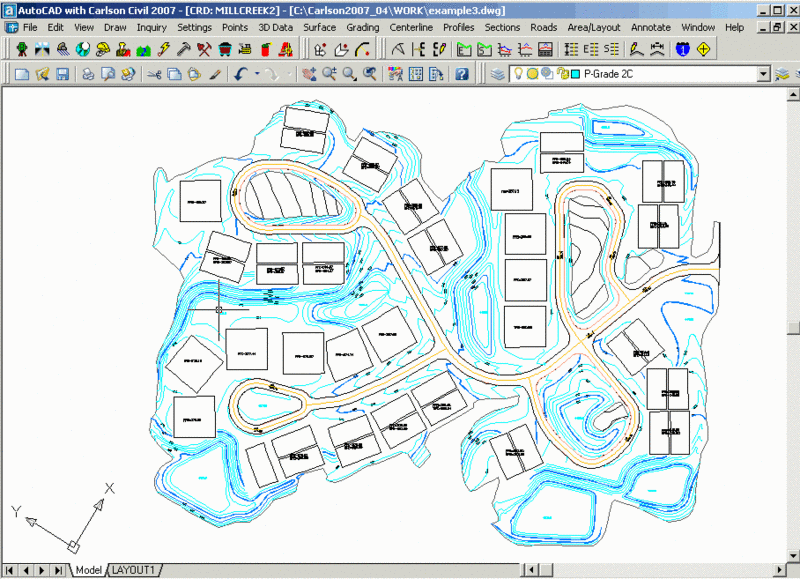

 You can also choose the
Color By Elevation toggle for better viewing of the
elevation range.
You can also choose the
Color By Elevation toggle for better viewing of the
elevation range. 
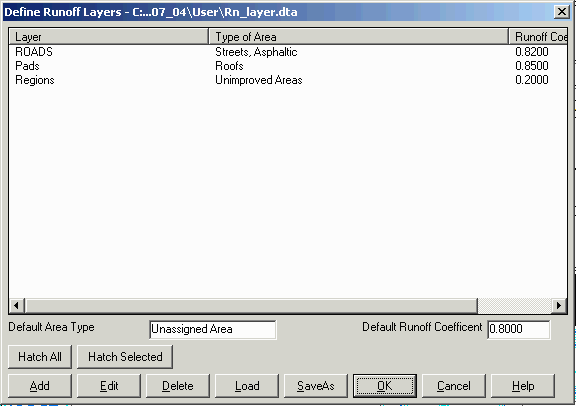

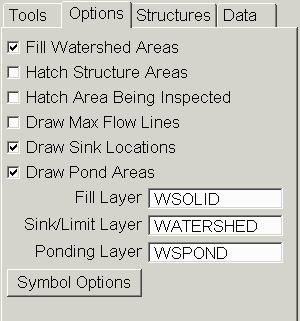
 next to the Draw Watershed Areas button to erase
all the watershed entities.
next to the Draw Watershed Areas button to erase
all the watershed entities.